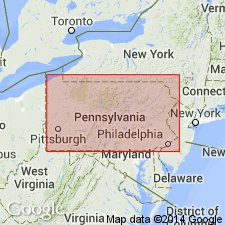
- Usage in publication:
-
- Snitz Creek member
- Modifications:
-
- Named
- Dominant lithology:
-
- Dolomite
- Limestone
- AAPG geologic province:
-
- Appalachian basin
Summary:
Named the Snitz Creek member of the Conococheague formation in southeastern PA. Name applied to dolomite sequence that stratigraphically overlies Buffalo Springs member; underlies Schaefferstown member. Composed of thick-bedded, light- to medium-gray dolomite, commonly oolitic, with medium-light-gray limestone or medium-gray shaly limestone interbeds; where coarsely crystalline, dolomite is commonly vuggy; shaly partings, often stylolitic, occur in dolomite; sandstone beds 1 to 1.5 feet thick present near top and base, with thinner sandy beds occurring throughout member; dark-gray to grayish-black chert locally abundant. Estimated thickness is 350 feet; partial type section is 62 feet thick with neither top nor base exposed. The Snitz Creek is of Late Cambrian age.
Source: GNU records (USGS DDS-6; Reston GNULEX).

- Usage in publication:
-
- Snitz Creek formation
- Modifications:
-
- Revised
- AAPG geologic province:
-
- Appalachian basin
Summary:
Raised the Snitz Creek to the Snitz Creek formation of the Conococheague group in southeastern PA.
Source: GNU records (USGS DDS-6; Reston GNULEX).

- Usage in publication:
-
- Snitz Creek Formation*
- Modifications:
-
- Overview
- AAPG geologic province:
-
- Appalachian basin
Summary:
The Snitz Creek Formation of the Conococheague Group consists of light-gray to dark-gray, very finely to finely crystalline dolomite; much of the dolomite is argillaceous, silty, or sandy. Thickness is 300 to 400 feet. Unit occurs is western part of Mount Joy belt. Overlies the Buffalo Springs Formation and underlies the Millbach Formation, both of the Conococheague Group.
Source: GNU records (USGS DDS-6; Reston GNULEX).

- Usage in publication:
-
- Snitz Creek Formation
- Modifications:
-
- Overview
- AAPG geologic province:
-
- Appalachian basin
Summary:
The Snitz Creek Formation in the Lebanon Valley sequence of the Great Valley consists of thick-bedded, medium- to coarsely-crystalline dolomite, in part oolitic, containing laminated limestone and sandstone interbeds. Overlies Buffalo Springs Formation and underlies Schaefferstown Formation.
Source: GNU records (USGS DDS-6; Reston GNULEX).
For more information, please contact Nancy Stamm, Geologic Names Committee Secretary.
Asterisk (*) indicates published by U.S. Geological Survey authors.
"No current usage" (†) implies that a name has been abandoned or has fallen into disuse. Former usage and, if known, replacement name given in parentheses ( ).
Slash (/) indicates name conflicts with nomenclatural guidelines (CSN, 1933; ACSN, 1961, 1970; NACSN, 1983, 2005, 2021). May be explained within brackets ([ ]).

